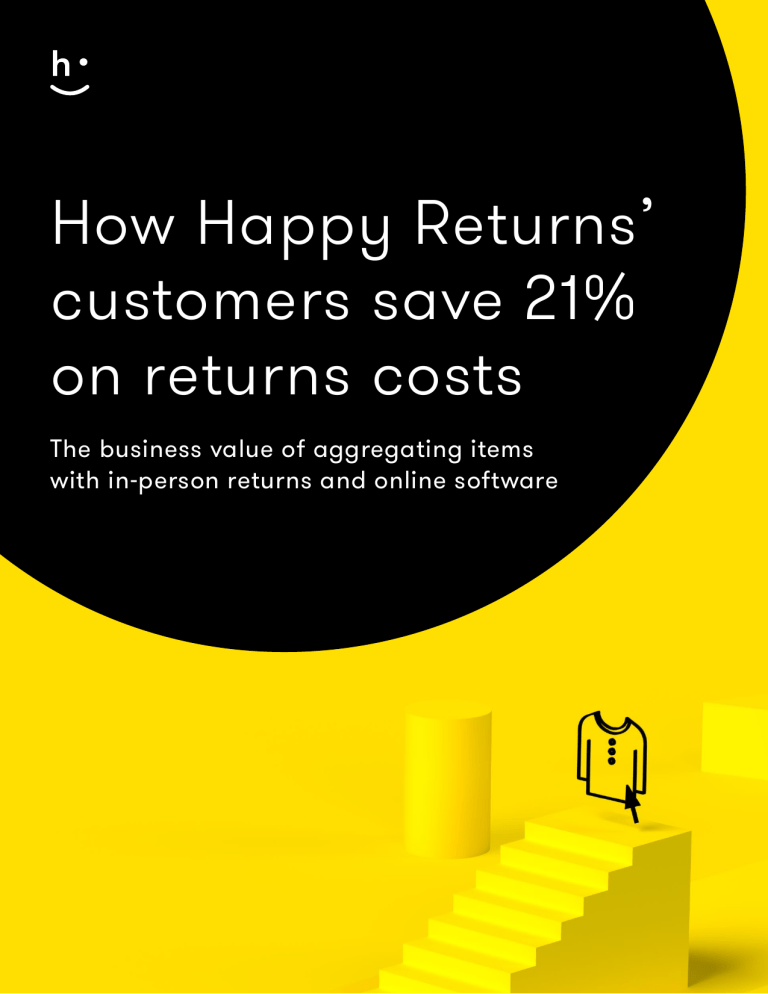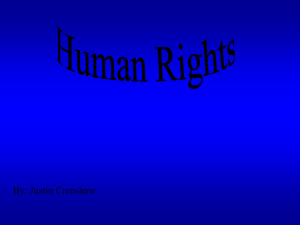
How Happy Returns’ customers save 21% on returns costs The business value of aggregating items with in-person returns and online software 02 Executive summary Retailers working with Happy Returns discover that they previously overspent on returns and reverse logistics. To quantify the hard savings we deliver, Happy Returns analyzed its customers’ return costs before and after using Happy Returns’ solutions. Assessed costs included: Carrier shipping fees Per-item fees for in-person returns via Happy Returns’ Return Bar network Returns software and/or Return Bar network subscription fees Returns processing charges (if applicable) Looking at the period February 2019 to February 2020, and including customers with at least six months of data during that period, Happy Returns’ customers utilizing our returns software and Return Bars on average saved 21%, compared to prior returns costs. Combined, the analysis covered millions of items with an average of 1.85 items per return. 03 Table of contents Executive summary 02 Research methodology 04 06 reverse logistics costs 10 11 12 Customer examples 14 17 04 Research methodology This ROI analysis compares retailers’ returns costs before and after they became Happy Returns’ customers. This included some retailers using Happy Returns' entire solution of returns software and in-person Return Bars, and another retailer set that only uses its Return Bars. To calculate each customer’s ROI, Happy Returns assessed the following costs: Carrier shipping fees prior to and after partnering with Happy Returns. In-person return shipping fees All retailers paid on a per-item basis for use of Happy Returns’ network of over 700 Return Bars, where shoppers return items in-person. (continued on next page) 05 Research methodology (continued) Returns software and Return Bar network subscription Before partnering with Happy Returns, some customers already used a shoppers to initiate returns (and sometimes exchanges) online. For other customers, Happy Returns was returns solution. The Return Bar network subscription is an incremental in-person return fees. Returns processing charges Before working with Happy Returns, retailers’ returned items were processed at third-party logistics providers. Some customers opted for all items, both in-person and by-mail, to be inspected and processed at Happy Returns’ regional hubs. Retailers provided their prior returns costs during our sales process. 06 21 % 19 Average savings when using Happy Returns’ software and Return Bars Average savings for all customers These savings were achieved in two primary ways... % 07 Scenario A represents traditional returns, where items are individually sent back through the mail in single-use cardboard. Scenario B represents items that are returned in-person to Return Bars, then aggregated together in reusable totes. Top contributors Aggregation of items Lower shipping rates When shoppers bring returns to Return Customers generally reduced shipping Bars, items are placed inside reusable costs with access to Happy Returns’ containers that hold up to ~20 items. carrier rates, which are low due to The containers are then shipped to Happy Returns’ aggregated Return Hubs and re-aggregated into purchasing power. being sent back. 08 Per-item costs On average, retailers using Happy Returns’ full solution paid $5.02 per item in shipping before becoming a customer. Retailers that only use Happy Returns’ Return Bars spent $4.24 per item. After partnering with Happy Returns, all customers averaged $1.98 per item when using Return Bars—and if using our returns software, $3.69 per item for returns by mail. BEFORE AND AFTER Retailers using Happy Returns’ full solution Retailers using Return Bars only Before Happy Returns Returns by mail Before Happy Returns Return Bars Return Bars 09 Retailers generate ROI in other ways that were not included in the hard cost savings calculation: from the increased exchange rates and decreased refunds. Both are attributable to the industry’s only one-click exchange feature. due to fewer shopper calls with returns and refund questions. Less overhead, more by managing only one vendor for all reverse logistics needs (if Happy Returns performs all processing). 10 Three drivers of expensive reverse logistics costs Traditional returns solutions are expensive due to: Individual shipments For retailers without stores, the only option for returns is the mail, which traditionally means shipping individual orders from the customer back to the warehouse. Shipping individual items is expensive, with no options for consolidation to reduce costs. Escalating carrier costs Shipping costs have increased each year, rising far faster than consumer prices. The recent introduction of dimensional-weight shipping has further increased returns-cost pressure on retailers. returns processing Many retailers don't consider the total cost of ownership when making a 3PL decision. Returns processing is a real cost of ownership in these relationships. Furthermore, brands often have to make the processing returns. Delayed returns processing leads to unhappy customers and drives expensive customer service calls inquiring about the status of refunds. 11 How Happy Returns’ end-to-end returns solution works 6 5 4 3 2 1 2 1 Return in person Return by mail 1 Shopper initiates the return online. 1 Shopper mails return. 2 Shopper visits the Return Bar. 2 3 Items are commingled in eco-friendly reusable tote. Package uses low shipping rates from group buying power across Happy Returns customers. 4 Robust technology inspects and processes items. 5 6 Totes are shipped back to the retailer. 12 With Happy Returns Return Bars, shoppers drop 13 Regional routing Intelligent, automated routing to nearby hubs like Happy Returns’ regional Blandon, PA Van Nuys, CA Intelligent processing 14 Customer examples The following customer examples reveal how three anonymous Happy Returns customers gained substantial savings. A contemporary women’s clothing company previously outsourced returns management to multiple third-party logistics providers. By exchanging the piecemeal approach for Happy Returns’ complete returns solution, Company A saved 31%. Per item shipping cost Before Happy Returns Returns by mail Return Bars (continued on next page) 15 Customer examples (continued) Prior to partnering with Happy Returns, a popular shoe retailer worked with a competing returns solution that shipped items back individually without processing them. After switching to Happy Returns, Customer B saved 21% on returns and reverse logistics costs. Per item shipping cost Before Happy Returns Returns by mail Return Bars (continued on next page) 16 Customer examples (continued) A plus-size clothing retailer that manually processed returns in-house before electing to use Happy Returns’ Return Bars. Customer C saved 35%. Per item shipping cost Returns by mail Return Bars 17 Conclusion By eliminating expensive returns costs, retailers free up dollars to invest in ecommerce adoption causes return volume to soar, along with the carrier rates that accompany that volume. As the competitive retail landscape important pillar for future growth. For more information about how you can reduce the cost of returns, visit Retailers.HappyReturns.com.



